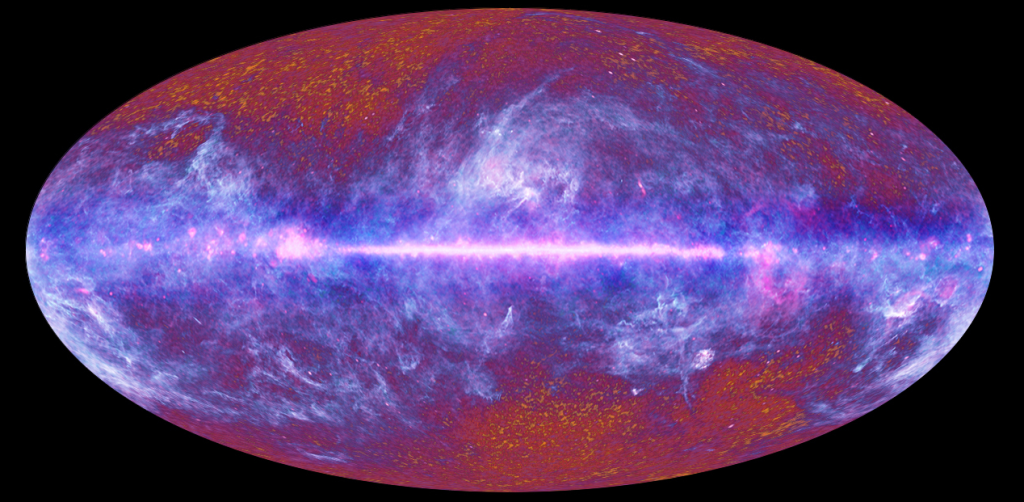A long-lost type of dark matter may resolve the biggest disagreement in physics
This stuff would have existed for thousands of years before disappearing.

One of the deepest mysteries in physics, known as the Hubble tension, could be explained by a long-since vanished form of dark matter.
The Hubble tension, as Live Science has previously reported, refers to a growing contradiction in physics: The universe is expanding, but different measurements produce different results for precisely how fast that is happening. Physicists explain the expansion rate with a number, known as the Hubble constant (H0). H0 describes an engine of sorts that’s driving things apart over vast distances across the universe. According to Hubble’s Law (where the constant originated), the farther away something is from us, the faster it's moving.
And there are two main ways of calculating H0. You can study the stars and galaxies we can see, and directly measure how fast they're moving away. Or you can study the cosmic microwave background (CMB), an afterglow of the Big Bang that fills the entire universe, and encodes key information about its expansion.
Related: The 11 Biggest Unanswered Questions About Dark Matter
As the tools for performing each of these measurements have gotten more precise, however, it's become clear that CMB measurement and direct measurements of our local universe produce incompatible answers.
Researchers have offered different explanations for the disparity, from problems with the measurements themselves to the possibility we live in a low-density "bubble" within the larger universe. Now, a team of physicists is suggesting that the universe might have fundamentally changed between the time after the Big Bang and today. If an ancient form of dark matter decayed out of existence, that loss would have changed the mass of the universe; and with less mass, there would be less gravity holding the universe together, which would have impact the speed at which the universe expands — leading to the contradiction between the CMB and the direct measurements of the universe's expansion rate.
A warm component
There was a time, decades ago, when physicists suspected dark matter might be "hot" — zipping around the universe at close to the speed of light, said Dan Hooper, head of the Theoretical Astrophysics Group at the Fermi National Accelerator Laboratory in Batavia, Illinois, and co-author of the new paper. But by the mid-1980s they were convinced that this unseen stuff that makes up most of the mass of the universe is likely slower-moving and "cold." Physicists refer to the mostly widely-accepted model of the universe as Lambda-CDM, for "Cold Dark Matter."
Breaking space news, the latest updates on rocket launches, skywatching events and more!
Still, Hooper told Live Science, the idea of "warm" dark matter — a form of dark matter that falls somewhere in between the hot and cold models — still gets some traction in the physics world. Some physicists speculate that dark matter is made of "sterile neutrinos," for example, theoretical ghostly particles that barely interact with matter. This hypothetical dark matter would be much warmer than typical Lambda-CDM models allow, but not hot.
"Another possibility is that most of the dark matter is cold, but maybe some of it is warm. And in our paper, the stuff that's warm isn't even stuff that's around today. It's stuff that was created in the early universe and after thousands or tens of thousands of years it started to decay. It's all gone by now," Hooper said.
Related: 11 fascinating facts about our Milky Way galaxy
That lost dark matter's mass would have represented a significant chunk of the total mass of the universe when it existed, leading to a different expansion rate when the CMB formed just after the Big Bang. Now, billions of years later, it would be long gone. And all the stars and galaxies we can measure would be moving away from us at speeds determined by the universe's current mass.
"When you measure the local Hubble constant you're really measuring that thing: You're measuring how fast things are moving apart from one another, you're measuring how fast space is expanding," Hooper said. But translating the CMB data into an expansion rate requires using a model, such as the Lambda-CDM. "So if you get different measurements from the local measurements and the CMB measurement, maybe that model's wrong."
Local measurements -- measurements of the region of space close enough to Earth for astronomers to precisely measure the speed and distance of individual objects -- don't require cosmological models to interpret, so they're typically seen as more straightforward and robust.
Some researchers have still suggested there may be problems with our measurements of the local universe. But most attempts to resolve the Hubble tension involve tweaking Lambda-CDM somehow. Usually, they add something to the model that changes how the universe expands or evolves. This paper, Hooper said, is another step down that road.
"I'm not going to give the impression that it makes everything great," he said. "It's not a perfect concordance among the data by any means. But it makes the tension less severe — I don't know of any solution to this, other than 'the measurements are wrong,' that reduces the tension [as much as you'd need to fully solve the problem]."
Dark Radiation
Hooper's original proposal to his collaborators on the paper didn't involve warm dark matter at all, he said. Instead, he imagined a second, lost form of cold dark matter. But when they started to test that idea, he said, they found that this extra cold dark matter was screwing up the whole structure of the universe. Stars and galaxies formed in ways that didn't match what we see around us in the universe today. The decayed, lost form of dark matter, they concluded, had to be warm if it was going to fit observations.
The new paper doesn't determine what particles the lost dark matter might be made of, but strongly suggests that warm dark matter might have been made up of sterile neutrinos — particles that other physicists also believe are likely out there.
"It's definitely the thing that requires the fewest number of tooth fairies to make work," Hooper said. "But other possibilities exist."
Whatever it is though, it must have turned into something even more exotic and feebly interacting when it decayed. Matter can't just stop existing; it has to transform into something else. If that something else were distributed differently through the universe, or interacted differently with other particles in the universe, that would change how the universe expanded.
"So we'd be surrounded in a bath of this dark radiation," Hooper said. "We're already surrounded in a bath of neutrinos so this would just be a little bit more of that kind of stuff. Some sort of bath that fills the universe today of very, very inert forms of matter."
For now, researchers don't have methods for probing the for this sort of hidden radiation, Hooper said, so the idea remains speculative. The paper was published to the arXiv database April 13.
- The biggest unsolved mysteries in physics
- The 11 biggest unanswered questions about dark matter
- The 15 weirdest galaxies in our universe
Originally published on Live Science.
OFFER: Save 45% on 'How It Works' 'All About Space' and 'All About History'!
For a limited time, you can take out a digital subscription to any of our best-selling science magazines for just $2.38 per month, or 45% off the standard price for the first three months.

Rafi wrote for Live Science from 2017 until 2021, when he became a technical writer for IBM Quantum. He has a bachelor's degree in journalism from Northwestern University’s Medill School of journalism. You can find his past science reporting at Inverse, Business Insider and Popular Science, and his past photojournalism on the Flash90 wire service and in the pages of The Courier Post of southern New Jersey.


